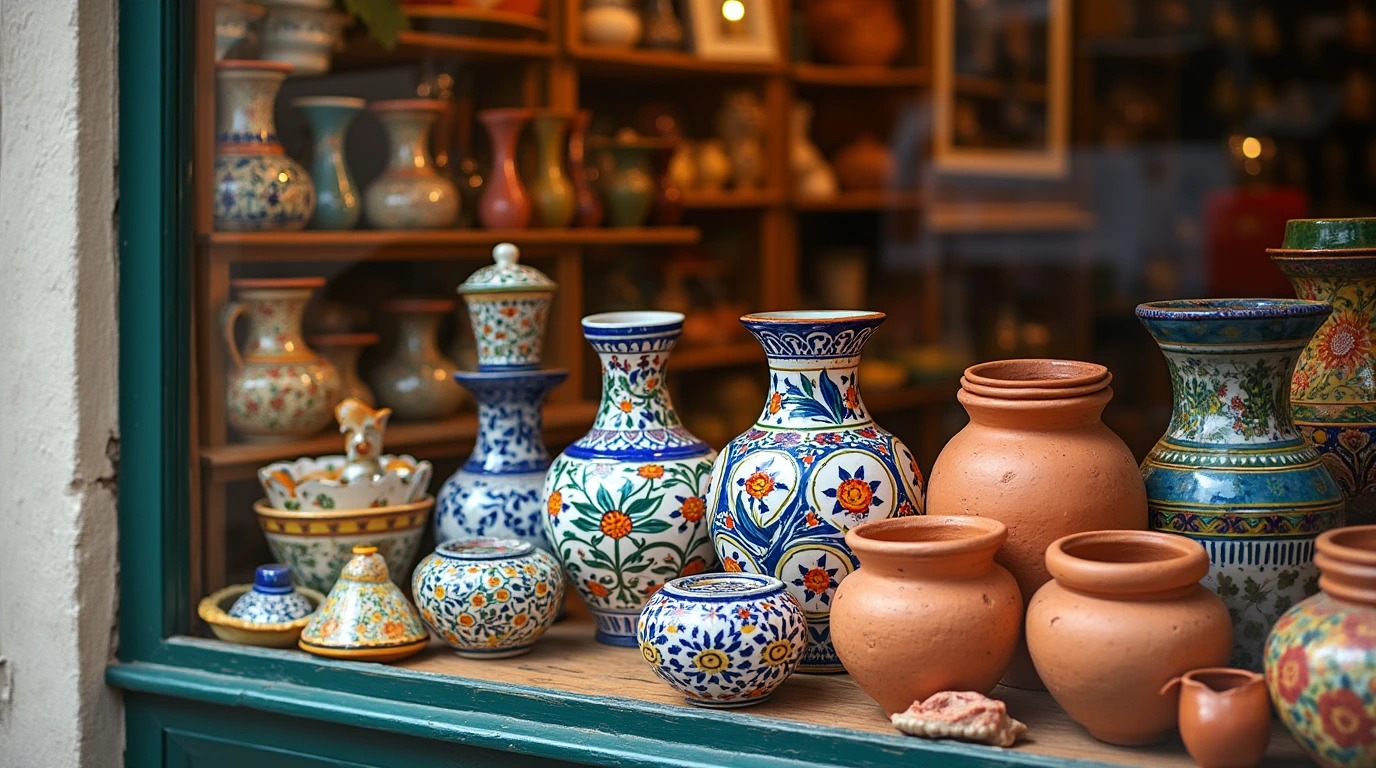Have you ever held a piece of pottery that seemed to whisper stories of the past? That’s the magic of Portugal pottery. More than just functional objects, these ceramics are vibrant expressions of culture, history, and the enduring artistry of the Portuguese people. Forget mass-produced items; we’re talking about handcrafted treasures, each with its own unique character and charm. In this article, we’ll dive headfirst into the captivating world of Portugal pottery, exploring its origins, different styles, how to care for it, and where to find the real deal.
Table of Contents
A Journey Through Portugal’s Ceramic Heritage
Portugal’s love affair with ceramics dates back centuries. Think about it: long before plastic and mass production, pottery was essential for everything from storing food and water to decorating homes and places of worship. Let’s take a step back in time and see how this art form evolved.
From Ancient Roots to Modern Artistry
The story of Portugal pottery begins with the Romans, who introduced sophisticated techniques and designs to the Iberian Peninsula, even establishing early centers like Cascais. Over time, these skills were refined and adapted by the Moors, leaving an indelible mark on Portuguese ceramics. This fusion of Roman and Moorish influences resulted in a unique style characterized by intricate patterns, vibrant colors, and a deep connection to the natural world. From humble beginnings, Portugal pottery has blossomed into a recognized art form, with contemporary artists constantly pushing boundaries while honoring their heritage.
Regional Variations: A Tapestry of Styles
What makes Portugal pottery so special is its incredible diversity. Just like the country itself, each region has its own distinct ceramic traditions.
For example, the Alentejo region is known for its rustic, earthy pottery, often adorned with simple yet charming motifs. In contrast, the Algarve region boasts brighter, more vibrant colors, reflecting the sunny Mediterranean climate. The north of Portugal is famous for its black pottery. Then you have the iconic blue-and-white azulejos that you can find all over the country. It’s like each region has its own dialect, speaking through clay and glaze! Isn’t that something?
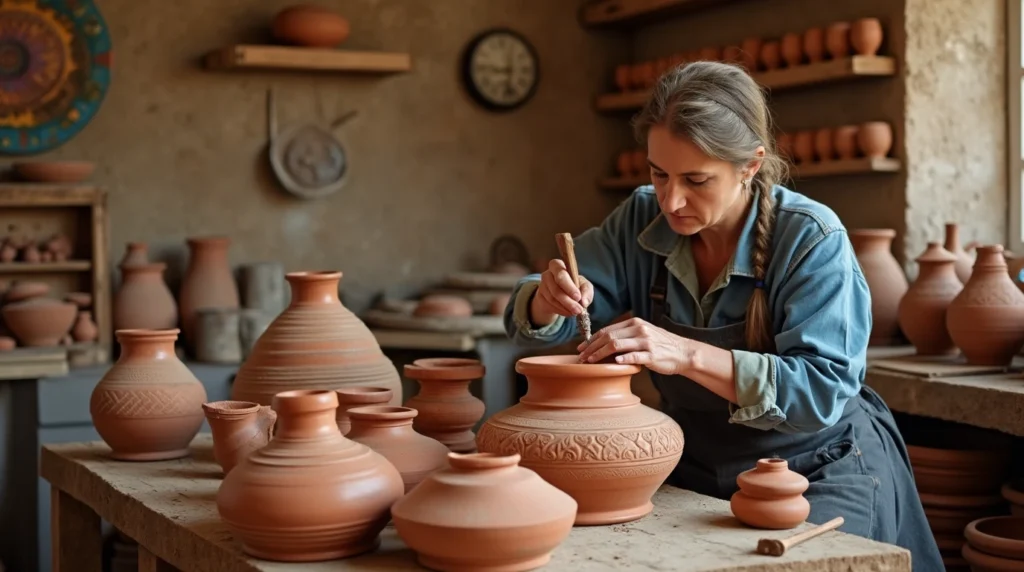
The Allure of Portugal Pottery: Why It Captivates
So, what is it about Portugal pottery that draws people in? Why do collectors and enthusiasts around the world seek out these pieces?
Handcrafted Beauty: The Mark of Authenticity
In a world of mass-produced items, the human touch is increasingly rare and valued. Portugal pottery, especially pieces originating from places like Caminha, is a testament to the skill and dedication of artisans who pour their heart and soul into each creation. Each piece is slightly different, with its own imperfections and quirks – a reminder that it was made by a real person, not a machine. This authenticity is a major part of its appeal. Can you really compare a mass-produced vase to one that has been lovingly shaped by hand? I don’t think so.
Vibrant Colors and Intricate Designs: A Visual Feast
From the deep blues of azulejos to the vibrant greens and yellows of Bordallo Pinheiro ceramics, Portugal pottery is a visual feast for the eyes. The intricate designs, often inspired by nature, history, or folklore, add another layer of depth and interest. These aren’t just functional items; they’re works of art that can transform any space. The artistry is just fantastic!
More Than Just Ceramics: A Cultural Expression
More than just pretty objects, Portugal pottery, much like Castelbel Soap with its evocative scents and packaging, is a powerful expression of Portuguese culture and identity. Each piece tells a story, reflecting the history, values, and traditions of the people who created it. Whether it’s a simple terracotta pot or an elaborate azulejo panel, Portugal pottery is a tangible link to the past and a celebration of the present. It’s a legacy passed down through generations.
“Portugal pottery is more than just clay; it’s a story etched in earth and fire, a testament to the enduring spirit of our artisans.” – Maria, a third-generation potter from Barcelos.
Exploring the Different Types of Portugal Pottery
Now that we’ve explored the rich heritage and appeal of Portugal pottery, let’s delve into some of the most iconic and distinctive types. Buckle up; it’s quite a journey!
Azulejos: Portugal’s Iconic Tiles
No discussion of Portugal pottery would be complete without mentioning azulejos. These glazed ceramic tiles are ubiquitous throughout Portugal, adorning everything from churches and palaces to train stations and private homes. Typically blue and white, azulejos often depict historical scenes, religious figures, or intricate geometric patterns. They’re not just decorative; they also serve a practical purpose, providing insulation and protecting buildings from the elements. Walking through Lisbon or Porto, you’re surrounded by these stunning works of art – they’re like open-air museums!
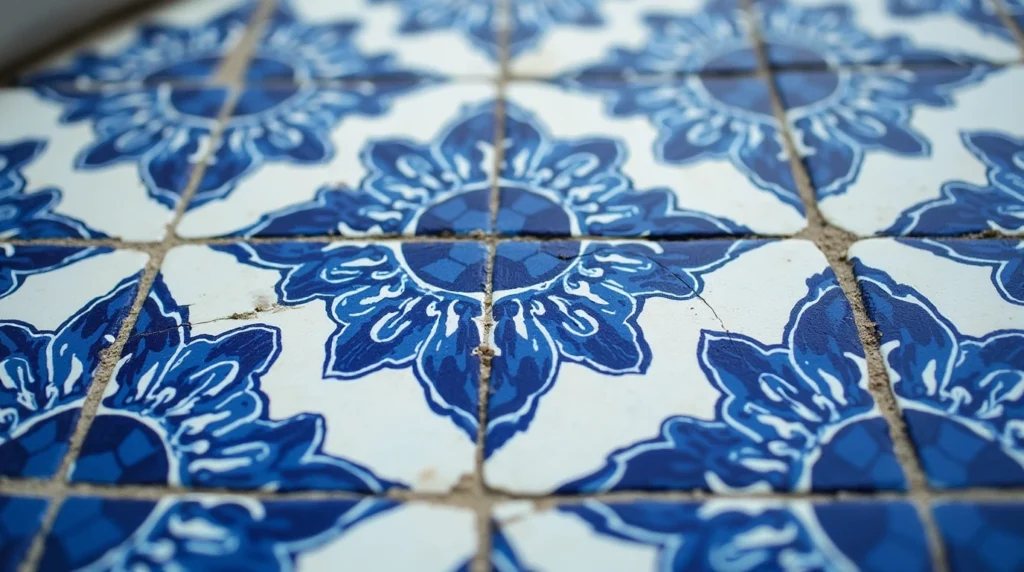
Bordallo Pinheiro: Whimsical and Wonderful
If you’re looking for pottery with a playful and humorous twist, look no further than Bordallo Pinheiro. Founded in 1884 by Rafael Bordallo Pinheiro, this iconic brand is known for its whimsical designs, often featuring animals, fruits, and vegetables. From cabbage-shaped bowls to sardine-shaped dishes, Bordallo Pinheiro ceramics are sure to bring a smile to your face. It’s like stepping into a fairytale! The detail and craftsmanship are just extraordinary.
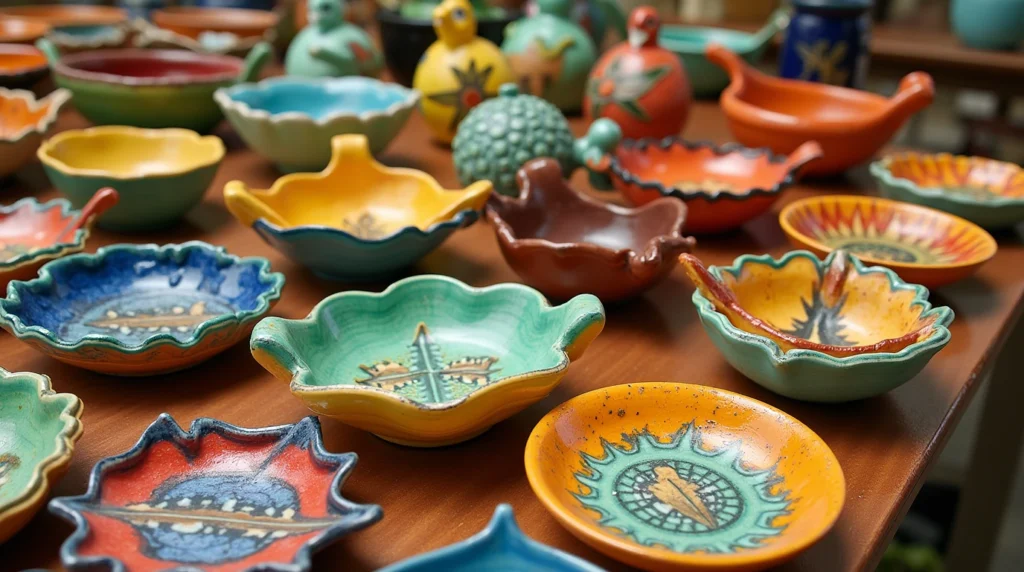
Cante Alentejano Pottery: Rustic Charm
Hailing from the Alentejo region, cante alentejano pottery is characterized by its rustic charm and earthy tones. These handmade pieces are often decorated with simple yet elegant motifs, reflecting the region’s rural landscape and agricultural traditions. Think terracotta pots, jugs, and bowls, perfect for adding a touch of warmth and authenticity to your home. It’s the kind of pottery that makes you want to cook a hearty stew and gather around a crackling fire!
Barcelos Rooster: A National Symbol in Ceramic Form
Ah, the Barcelos Rooster! This iconic symbol of Portugal, as instantly recognizable as Portugal Traditional Clothing, is often depicted in ceramic form, making it a popular souvenir and a beloved piece of folk art. Legend has it that the rooster saved a man from being wrongly accused of a crime, becoming a symbol of justice, faith, and good luck. Whether you believe the legend or not, the Barcelos Rooster is a vibrant and cheerful addition to any collection. You’ll find them in all shapes, sizes, and colors – a true celebration of Portuguese culture.
“The Barcelos Rooster represents the indomitable spirit of Portugal. It’s a reminder that even in the darkest of times, hope and justice will prevail.” – António, a local historian from Barcelos.
Now, let’s pause for a moment. Imagine yourself strolling through a bustling Portuguese market, the air filled with the aroma of fresh bread and the sounds of lively chatter. Your eyes are drawn to a vibrant display of Portugal pottery, each piece whispering stories of its creation. You reach out and touch a hand-painted azulejo, feeling the smooth glaze beneath your fingertips. This isn’t just shopping; it’s an immersion into Portuguese culture, a connection to the past, and a celebration of the present. It’s truly an experience.
Common Problems with Portugal Pottery (and How to Solve Them)
Okay, let’s be real. Owning beautiful Portugal pottery isn’t always sunshine and roses. Like any treasured possession, it can face a few challenges. But don’t worry! We’re going to tackle those common problems head-on and provide you with practical solutions. So, you can keep those gorgeous pieces in tip-top shape for years to come!
Cracking and Breakage: Prevention and Repair
The Problem: Let’s face it, accidents happen. Pottery, being inherently fragile, is susceptible to cracking and breakage. A clumsy bump, a sudden temperature change, or even just the passage of time can lead to these unfortunate events. Ugh!
The Solution:
- Prevention is Key: Handle your Portugal pottery with care. Avoid stacking heavy items on top of it, and protect it from sudden temperature fluctuations. Use padded shelves or display cases to minimize the risk of accidental bumps.
- Quick Repairs: For minor cracks, epoxy resin adhesives designed for ceramics can work wonders. Clean the surfaces thoroughly before applying the adhesive, and follow the manufacturer’s instructions carefully.
- Professional Help: For significant breaks or valuable pieces, it’s best to consult a professional ceramic restorer. They have the expertise and specialized materials to restore your pottery to its former glory. Don’t try to fix a shattered piece yourself; you’ll probably just make it worse.
Fading Colors: Protecting Your Pottery’s Vibrancy
The Problem: Those vibrant colors that make Portugal pottery so captivating can fade over time, especially when exposed to direct sunlight or harsh cleaning agents. Nobody wants their once-brilliant azulejos to turn dull and lifeless!
The Solution:
- Avoid Direct Sunlight: Display your pottery away from direct sunlight, which can cause the colors to fade. Use curtains, blinds, or UV-filtering window film to protect your collection.
- Gentle Cleaning: Use mild, pH-neutral detergents and soft cloths to clean your pottery. Avoid abrasive cleaners, scouring pads, and harsh chemicals, which can damage the glaze and fade the colors.
- Protective Coatings: Consider applying a protective coating designed for ceramics. These coatings can help shield your pottery from UV rays, dust, and other environmental factors. Just make sure the coating is suitable for your specific type of pottery.
Authenticity Concerns: Identifying Genuine Pieces
The Problem: With the popularity of Portugal pottery, there’s a growing risk of encountering counterfeit or misrepresented pieces. It can be tough to tell the real deal from a cheap imitation, especially if you’re not an expert. You don’t want to pay a premium price for something that’s not authentic.
The Solution:
- Research and Education: Familiarize yourself with the characteristics of genuine Portugal pottery, including the typical designs, materials, and markings. The more you know, the better equipped you’ll be to spot fakes.
- Buy from Reputable Sources: Purchase your pottery from reputable dealers, galleries, or artisan workshops. Avoid buying from unknown sources or online marketplaces with questionable reputations.
- Look for Markings: Check for maker’s marks, signatures, or other identifying marks that can help verify the authenticity of the piece. Not all pieces are marked, but the presence of a genuine mark is a good sign.
- Trust Your Gut: If something seems too good to be true, it probably is. If the price is significantly lower than comparable pieces, or if the quality seems subpar, proceed with caution.
“Authenticity is not just about the markings on the pottery; it’s about the story it tells, the spirit of the artisan, and the connection to Portugal’s rich cultural heritage.” – Sofia, a renowned art appraiser specializing in Portugal pottery.
Imagine you’re at a flea market, and a vendor tries to sell you a supposed Bordallo Pinheiro cabbage bowl for a ridiculously low price. The glaze looks a bit off, and there are no markings. Red flags should be waving! Always trust your instincts and do your homework before making a purchase.
Caring for Your Portugal Pottery Collection
Alright, you’ve found some gorgeous Portugal pottery, you’ve avoided the common pitfalls, now how do you keep it looking beautiful for years to come? Proper care and maintenance are crucial for preserving the value and beauty of your collection. Let’s dive into some essential tips.
Cleaning and Maintenance Tips
Okay, think of your pottery collection as you would a beloved pet—it needs regular attention and a little bit of TLC to stay healthy and happy!
- Dusting is Key: Dust is the enemy! Regularly dust your pottery with a soft brush or microfiber cloth to prevent buildup. Make sure to get into all those little nooks and crannies.
- Handwashing is Best: While some pieces might technically be dishwasher safe, handwashing is always the gentlest option. Use warm water, a mild dish soap (phosphate-free!), and a soft sponge. Avoid harsh scrubbing, which can scratch the glaze.
- Soaking Stubborn Stains: Got a stubborn stain? Don’t panic! Soak the piece in warm water with a little bit of baking soda for a few hours. This can often loosen the stain without damaging the pottery.
- Drying with Care: After washing, dry your pottery thoroughly with a soft towel. Leaving it to air dry can sometimes lead to water spots.
- Avoid Abrasives: Say NO to abrasive cleaners, scouring pads, and steel wool. They can scratch the surface and dull the colors.
- Handle with Love: Sounds obvious, right? But remember to always handle your pottery with care. Support it from the bottom when lifting and avoid carrying too many pieces at once.
Displaying Your Pottery: Creating a Stunning Showcase
Your Portugal pottery is more than just stuff; it’s art! So, it deserves a display that shows it off and makes you feel good every time you see it.
- Consider the Space: Think about the room where you’ll be displaying your pottery. What’s the overall style? What colors are dominant? Choose a display that complements the existing décor.
- Create Levels: Use shelves, risers, or display stands to create visual interest and prevent everything from looking flat. Varying the heights of the pieces can also help to showcase them better.
- Light it Up!: Proper lighting can make a HUGE difference. Use spotlights or track lighting to highlight your pottery and bring out its colors and details. Be mindful of heat, though; avoid placing pottery too close to hot lights.
- Group by Theme or Color: Grouping pieces by theme (e.g., azulejos, Bordallo Pinheiro) or color can create a cohesive and visually appealing display.
- Don’t Overcrowd: Resist the urge to cram everything onto one shelf. Give each piece enough space to breathe and be appreciated. Less is often more!
- Rotate Your Display: Keep things interesting by rotating your display periodically. This allows you to showcase different pieces and prevent any one item from fading in direct sunlight.
Think about creating a little vignette on a bookshelf: a vibrant Barcelos rooster perched next to a stack of antique books, with a small azulejo tile leaning against the wall. It’s all about telling a story and creating a mood.
Where to Find Authentic Portugal Pottery
So, you’re captivated by the allure of Portugal pottery and ready to start your own collection. Fantastic! But where do you even begin your search for authentic pieces? Fear not, intrepid collector! Here are some top destinations and tips for finding genuine treasures:
Visiting Pottery Workshops and Studios
For a truly immersive experience, there’s nothing quite like visiting a pottery workshop or studio in Portugal. Not only will you have the opportunity to see the artisans at work, but you’ll also be able to purchase unique, handcrafted pieces directly from the source.
- Research beforehand: Before you go, do some research to identify reputable workshops and studios in the regions you’re planning to visit. Look for places that have a long history of pottery production and a commitment to traditional techniques.
- Talk to the Artisans: Don’t be afraid to strike up a conversation with the artisans. Ask them about their craft, their inspiration, and the history of their pottery. You’ll gain a deeper appreciation for the art and the people who create it.
- Look for Quality: Examine the pottery carefully for signs of quality craftsmanship. Look for smooth glazes, intricate designs, and sturdy construction.
- Be Prepared to Pay a Premium: Handcrafted pottery from reputable workshops often comes with a higher price tag than mass-produced items. But remember, you’re paying for quality, authenticity, and the skill of the artisan.
Imagine stepping into a sun-drenched studio in Barcelos, the air filled with the earthy scent of clay and the rhythmic whir of the potter’s wheel. You watch in awe as a skilled artisan transforms a lump of clay into a vibrant Barcelos rooster, each detail meticulously hand-painted. It’s an experience you won’t soon forget!
Exploring Local Markets and Artisan Fairs
Local markets and artisan fairs are another excellent source for finding authentic Portugal pottery. These events often showcase the work of local artisans and craftspeople, offering a wide variety of unique and affordable pieces.
- Check for Authenticity: While markets can be a great place to find bargains, be sure to check for authenticity. Look for pieces that are clearly handmade and have the characteristics of genuine Portugal pottery.
- Haggle Respectfully: Haggling is often expected at markets in Portugal, but be sure to do it respectfully. Start with a reasonable offer and be prepared to negotiate.
- Support Local Artisans: By purchasing from local markets and artisan fairs, you’re supporting the livelihoods of local artisans and helping to preserve traditional crafts.
Picture yourself wandering through a bustling market in Lisbon, the vibrant colors and sounds of the city swirling around you. You stumble upon a stall overflowing with azulejos, each one a miniature work of art. You carefully select a few of your favorites, knowing that you’re taking home a piece of Portuguese history and culture.
Reputable Online Retailers: Buying with Confidence
If you can’t make it to Portugal in person, reputable online retailers can be a convenient way to purchase authentic pottery. However, it’s crucial to choose your sources carefully to avoid counterfeit or misrepresented pieces.
- Look for Established Retailers: Choose online retailers that have a long history of selling authentic Portugal pottery and a good reputation.
- Read Reviews: Check customer reviews to see what other buyers have to say about the quality of the pottery and the retailer’s customer service.
- Check for Return Policies: Make sure the retailer has a clear and fair return policy in case you’re not satisfied with your purchase.
- Examine Photos Carefully: Before you buy, examine the photos of the pottery carefully. Look for clear, high-resolution images that show the details of the piece.
- Ask Questions: Don’t hesitate to contact the retailer with any questions you have about the pottery. A reputable retailer will be happy to provide you with additional information and answer your concerns.
Finding a reliable online retailer can be a game-changer. Look for those who partner directly with Portuguese artisans or have a strong vetting process to ensure authenticity.
The Future of Portugal Pottery: Tradition Meets Innovation
Portugal pottery has a rich and fascinating history, but what about the future? How will this ancient craft adapt to the challenges and opportunities of the 21st century? The answer, it seems, lies in a delicate balance between tradition and innovation.
Sustainable Practices in Pottery Production
In an increasingly environmentally conscious world, sustainable practices are becoming essential for all industries, including pottery production. Portuguese artisans are embracing new techniques and materials to minimize their environmental impact.
- Using Recycled Materials: Some potters are incorporating recycled materials, such as crushed glass or reclaimed clay, into their pottery. This reduces waste and conserves natural resources.
- Eco-Friendly Glazes: Many artisans are switching to eco-friendly glazes that are free of harmful chemicals and heavy metals.
- Energy-Efficient Kilns: Potters are investing in energy-efficient kilns that use less electricity or gas, reducing their carbon footprint.
- Water Conservation: Water is a precious resource, and potters are implementing water conservation measures in their studios, such as recycling water used for cleaning.
It’s inspiring to see these artisans embracing sustainable practices, demonstrating a commitment to both their craft and the environment. It just goes to show that tradition and innovation can go hand in hand.
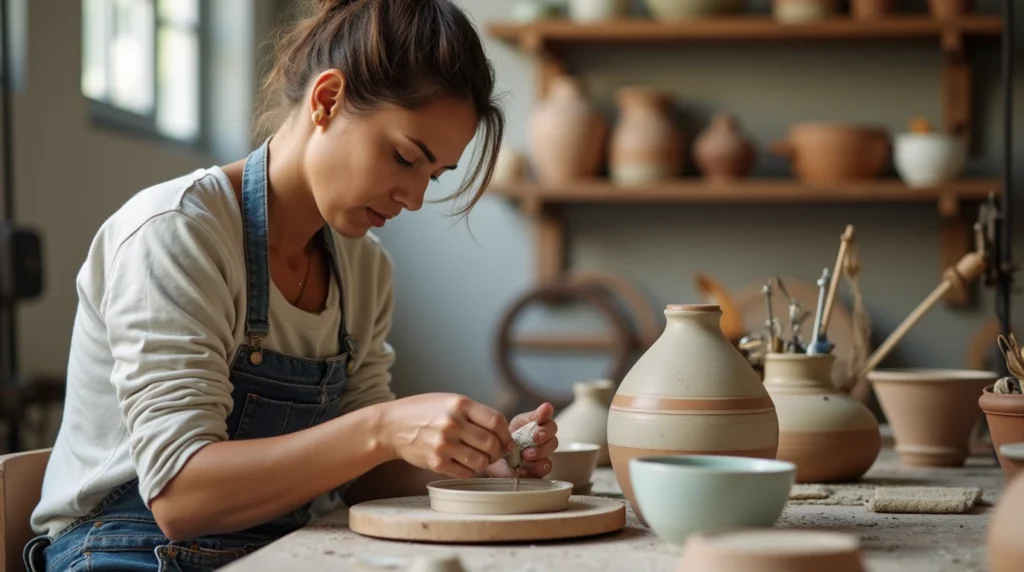
Emerging Artists and Modern Designs
While respecting tradition is important, Portugal pottery is also evolving thanks to the creativity and vision of emerging artists. These artists are experimenting with new techniques, materials, and designs, pushing the boundaries of what’s possible with clay.
- Contemporary Forms: Some artists are creating sleek, modern forms that contrast with the more traditional designs of the past.
- Mixed Media: Others are incorporating other materials, such as metal, wood, or glass, into their pottery, creating unique and unexpected combinations.
- Abstract Designs: Many artists are experimenting with abstract designs, using color, texture, and form to express their artistic vision.
- Functional Art: Some artists are creating functional art pieces that are both beautiful and practical, blurring the line between art and design.
These emerging artists are breathing new life into Portugal pottery, ensuring that it remains relevant and vibrant for generations to come. They prove that you can honor the past while embracing the future.
Portugal Pottery: A Timeless Treasure
From its ancient roots to its modern expressions, Portugal pottery is a timeless treasure that deserves to be celebrated and cherished. It’s more than just clay and glaze; it’s a tangible connection to the past, a celebration of the present, and a promise for the future.
Whether you’re a seasoned collector or a curious newcomer, I hope this article has inspired you to explore the enchanting world of Portugal pottery. Discover the beauty, the artistry, and the stories that these ceramics have to offer. Embrace the tradition, celebrate the innovation, and let Portugal pottery bring a touch of Portuguese magic into your life.
So, go ahead, find that special piece that speaks to you. Cherish it, care for it, and let it remind you of the rich cultural heritage of Portugal. Because in the end, Portugal pottery is more than just a thing; it’s an experience, a connection, and a piece of art that you can hold in your hand. And isn’t that something truly special?


